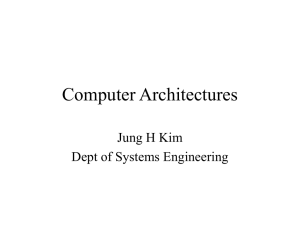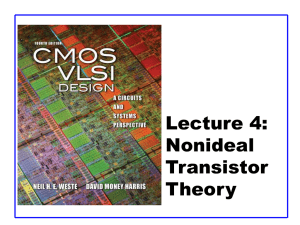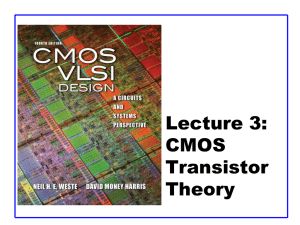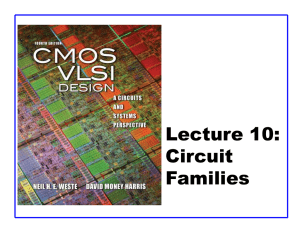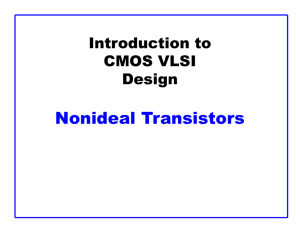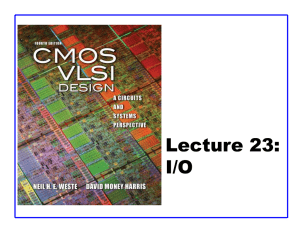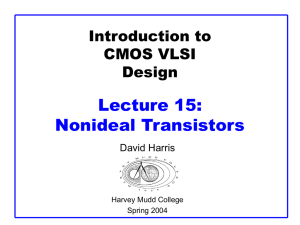Lecture 12-power-examples
advertisement
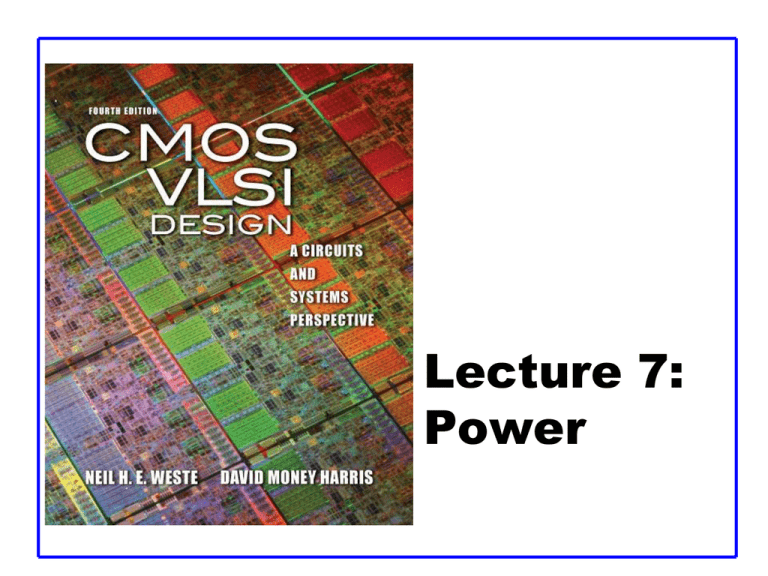
Lecture 7: Power Activity Factor Estimation Activity factor: probability a that a node switches 0→1 Define probability Pi that a node is “1” Probability that a node is “0” is then Pi = 1-Pi ai = Pi * Pi Completely random data has P = 0.5 and a = 0.25 Data is often not completely random Data propagating through ANDs and ORs has lower activity factor – Depends on design, but typically a ≈ 0.1 7: Power CMOS VLSI Design 4th Ed. 2 Switching Probability 7: Power CMOS VLSI Design 4th Ed. 3 Example A 4-input AND is built out of two levels of gates Estimate the activity factor at each node if the inputs have P = 0.5 NAND: If A and B are ”ones” there will be a ”0” output: PNAND=1-PAPB NOR: If n1 and n2 are ”zeroes” there will be a ”1” output: PNOR=P1P2 NAND NOR NAND 7: Power CMOS VLSI Design 4th Ed. 4 ON and OFF Current Ion = Ids @ Vgs = Vds = VDD – Saturation Ids (A) 1000 Ion = 747 mA @ Vgs = Vds = VDD 800 Vgs = 1.0 600 Vgs = 0.8 400 Vgs = 0.6 200 Vgs = 0.4 0 Vds 0 0.2 0.4 0.6 0.8 1 Ioff = Ids @ Vgs = 0, Vds = VDD – Cutoff 4: Nonideal Transistor Theory CMOS VLSI Design 4th Ed. 5 Leakage Sources Subthreshold conduction – Transistors can’t abruptly turn ON or OFF – Dominant source in contemporary transistors Gate leakage – Tunneling through ultrathin gate dielectric Junction leakage – Reverse-biased PN junction diode current 4: Nonideal Transistor Theory CMOS VLSI Design 4th Ed. 6 Leakage What about current in cutoff? Simulated results What differs? – Current doesn’t go to 0 in cutoff 4: Nonideal Transistor Theory CMOS VLSI Design 4th Ed. 7 DIBL Electric field from drain affects channel More pronounced in small transistors where the drain is closer to the channel Drain-Induced Barrier Lowering VVV – Drain voltage also affect Vt ttds V t V t V ds High drain voltage causes current to increase. 4: Nonideal Transistor Theory CMOS VLSI Design 4th Ed. 8 Threshold Voltage Effects Vt is Vgs for which the channel starts to invert Ideal models assumed Vt is constant Really depends (weakly) on almost everything else: – Body voltage: Body Effect – Drain voltage: Drain-Induced Barrier Lowering – Channel length: Short Channel Effect 4: Nonideal Transistor Theory CMOS VLSI Design 4th Ed. 9 Body Effect Body is a fourth transistor terminal Vsb affects the charge required to invert the channel – Increasing Vs or decreasing Vb increases Vt Vt Vt 0 g f s V sb f s fs = surface potential at threshold f s 2 v T ln NA ni – Depends on doping level NA – And intrinsic carrier concentration ni g = body effect coefficient g t ox ox 2 q si N A 4: Nonideal Transistor Theory 2 q si N A C ox CMOS VLSI Design 4th Ed. 10 Body Effect Body is a fourth transistor terminal Vsb affects the charge required to invert the channel – Increasing Vs or decreasing Vb increases Vt Vt Vt 0 g f s V sb f s fs = surface potential at threshold f s 2 v T ln NA ni – Depends on doping level NA – And intrinsic carrier concentration ni g = body effect coefficient g t ox ox 2 q si N A 4: Nonideal Transistor Theory 2 q si N A C ox CMOS VLSI Design 4th Ed. 11 Body Effect Cont. For small source-to-body voltage, treat as linear 4: Nonideal Transistor Theory CMOS VLSI Design 4th Ed. 12 Gate Leakage Carriers tunnel thorough very thin gate oxides Exponentially sensitive to tox and VDD – A and B are tech constants – Greater for electrons • So nMOS gates leak more Negligible for older processes (tox > 20 Å) Critically important at 65 nm and below (tox ≈ 10.5 Å) From [Song01] 4: Nonideal Transistor Theory CMOS VLSI Design 4th Ed. 13 Subthreshold Leakage Subthreshold leakage exponential with Vgs V gs V t 0 V ds k g V sb I ds I ds 0 e nvT V ds v 1 e T n is process dependent – typically 1.3-1.7 Rewrite relative to Ioff on log scale S ≈ 100 mV/decade @ room temperature 4: Nonideal Transistor Theory CMOS VLSI Design 4th Ed. 14 Subthreshold Leakage For Vds > 50 mV V gs V ds V D D k g V sb I sub I off 10 S Ioff = leakage at Vgs = 0, Vds = VDD 7: Power Typical values in 65 nm Ioff = 100 nA/m @ Vt = 0.3 V Ioff = 10 nA/m @ Vt = 0.4 V Ioff = 1 nA/m @ Vt = 0.5 V = 0.1 kg = 0.1 S = 100 mV/decade CMOS VLSI Design 4th Ed. 15 Stack Effect Series OFF transistors have less leakage – Vx > 0, so N2 has negative Vgs V x V D D I sub I off 10 V x V D D V x V D D k g V x S I off 10 S N1 Vx N2 VDD 1 2 k g I sub I off 10 1 k g V D D 1 2 k g S V D D I off 10 S – Leakage through 2-stack reduces ~10x – Leakage through 3-stack reduces further 7: Power CMOS VLSI Design 4th Ed. 16 NAND3 Leakage Example 100 nm process Ign = 6.3 nA Igp = 0 Ioffn = 5.63 nA Ioffp = 9.3 nA Data from [Lee03] 7: Power CMOS VLSI Design 4th Ed. 17 Lecture 10: Circuit Families CMOS VLSI Design 4th Ed. Outline Pseudo-nMOS Logic Dynamic Logic Pass Transistor Logic 10: Circuit Families CMOS VLSI Design 4th Ed. 19 Introduction What makes a circuit fast? – I = C dV/dt -> tpd (C/I) DV – low capacitance – high current 4 B – small swing 4 A Logical effort is proportional to C/I 1 1 pMOS are the enemy! – High capacitance for a given current Can we take the pMOS capacitance off the input? Various circuit families try to do this… 10: Circuit Families CMOS VLSI Design 4th Ed. Y 20 Pseudo-nMOS In the old days, nMOS processes had no pMOS – Instead, use pull-up transistor that is always ON In CMOS, use a pMOS that is always ON – Ratio issue – Make pMOS about ¼ effective strength of pulldown network 1.8 1.5 load P/2 1.2 P = 24 Ids Vout 0.9 Vout 16/2 Vin 0.6 P = 14 0.3 P=4 0 0 0.3 0.6 0.9 1.2 1.5 1.8 Vin 10: Circuit Families CMOS VLSI Design 4th Ed. 21 Dynamic Logic Dynamic gates uses a clocked pMOS pullup Two modes: precharge and evaluate 2 A f 2/3 Y 1 Y 1 A Static 4/3 Pseudo-nMOS f Precharge Y A 1 Dynamic Evaluate Precharge Y 10: Circuit Families CMOS VLSI Design 4th Ed. 22 The Foot What if pulldown network is ON during precharge? Use series evaluation transistor to prevent fight. precharge transistor f Y f f Y inputs A Y inputs f f foot footed 10: Circuit Families CMOS VLSI Design 4th Ed. unfooted 23 Monotonicity Dynamic gates require monotonically rising inputs during evaluation f – 0 -> 0 A – 0 -> 1 – 1 -> 1 violates monotonicity – But not 1 -> 0 during evaluation A f Precharge Evaluate Precharge Y Output should rise but does not 10: Circuit Families CMOS VLSI Design 4th Ed. 24 Monotonicity Woes But dynamic gates produce monotonically falling outputs during evaluation Illegal for one dynamic gate to drive another! A=1 f A Y f Precharge Evaluate Precharge X X X monotonically falls during evaluation Y Y should rise but cannot 10: Circuit Families CMOS VLSI Design 4th Ed. 25 Domino Gates Follow dynamic stage with inverting static gate – Dynamic / static pair is called domino gate – Produces monotonic outputs f Precharge Evaluate Precharge domino AND W W X Y Z X A B C f Y Z dynamic static NAND inverter f A B 10: Circuit Families f f W X H C CMOS VLSI Design 4th Ed. Y H Z = A B f X Z C 26 Charge Sharing Dynamic gates suffer from charge sharing f f A Y CY x A Y B=0 Cx Charge sharing noise x V x VY 10: Circuit Families CMOS VLSI Design 4th Ed. CY C x CY V DD 27


